You can Download Samacheer Kalvi 10th Science Book Solutions Guide Pdf, Tamilnadu State Board help you to revise the complete Syllabus and score more marks in your examinations.
Tamilnadu Samacheer Kalvi 10th Science Solutions Chapter 12 Plant Anatomy and Plant Physiology
Samacheer Kalvi 10th Science Plant Anatomy and Plant Physiology Textual Evaluation Solved
I. Choose the correct answer.
Question 1.
Casparian strips are present in the ______ of the root.
(a) cortex
(b) pith
(c) pericycle
(d) endodermis.
Answer:
(d) endodermis
Question 2.
The endarch condition is the characteristic feature of:
(a) root
(b) stem
(c) leaves
(d) flower
Answer:
(b) stem
You can Download Samacheer Kalvi 10th Science Guide Pdf, Tamilnadu State Board help you to revise the complete Syllabus and score more marks in your examinations.
Question 3.
The xylem and phloem arranged side by side on same radius is called ______.
(a) radial
(b) amphivasal
(c) conjoint
(d) none of these.
Answer:
(c) conjoint
Question 4.
Which is formed during anaerobic respiration?
(a) Carbohydrate
(b) Ethyl alcohol
(c) Acetyl CoA
(d) Pyruvate.
Answer:
(b) Ethyl alcohol
![]()
Question 5.
Kreb’s cycle takes place in:
(a) chloroplast
(b) mitochondrial matrix
(c) stomata
(d) inner mitochondrial membrane
Answer:
(b) mitochondrial matrix
Question 6.
Oxygen is produced at what point during photosynthesis?
(a) when ATP is converted to ADP
(b) when CO2 is fixed
(c) when H2O is splitted
(d) All of these.
Answer:
(b) when CO2 is fixed
II. Fill in the blanks
Question 1.
Cortex lies between ______.
Answer:
Epidermis and endodermis.
Question 2.
Xylem and phloem occur on the same radius constitute a vascular bundle called ______.
Answer:
Conjoint.
Question 3.
Glycolysis takes place in ______.
Answer:
The cytoplasm of the cell.
Question 4.
The source of O2 liberated in photosynthesis is ______.
Answer:
Byproduct.
![]()
Question 5.
________ is ATP factory of the cells.
Answer:
Mitochondria.
III. State whether the statements are true or false. Correct the false statement
Question 1.
Phloem tissue is involved in the transport of water in a plant.
Answer:
False.
Correct Statement: Phloem tissue is involved in the transport of food in plants.
Question 2.
The waxy protective covering of a plant is called cuticle.
Answer:
True.
Question 3.
In monocot, stem cambium is present in between xylem and phloem.
Answer:
False.
Correct Statement: In monocot stem, the cambium is absent in between xylem and phloem.
Question 4.
Palisade parenchyma cells occur below the upper epidermis in dicot root.
Answer:
False.
Correct Statement: Palisade parenchyma cells occur below the upper epidermis in dicot leaf.
Question 5.
Mesophyll contains chlorophyll.
Answer:
True.
![]()
Question 6.
Anaerobic respiration produces more ATP than aerobic respiration.
Answer:
True.
IV. Match the following
Question 1.
| 1. Amphicribal | (a) Dracaena |
| 2. Cambium | (b) Translocation of food |
| 3. Amphivasal | (c) Fern |
| 4. Xylem | (d) Secondary growth |
| 5. Phloem | (e) Conduction of water |
Answer:
1. (c) Fem
2. (d) Secondary growth
3. (a) Dracaena
4. (e) Conduction of water
5. (b) Translocation of food.
V. Answer in a Sentence
Question 1.
What is the collateral vascular bundle?
Answer:
When xylem lies towards the centre and phloem lies towards the periphery, it is called the collateral vascular bundle.
Question 2.
Where does the carbon that is used in photosynthesis come from?
Answer:
Carbondioxide present in atmosphere.
Question 3.
What is the common step in the aerobic and anaerobic pathway?
Answer:
Glycolysis is the common step in the aerobic and anaerobic pathway.
Question 4.
Name the phenomenon by which carbohydrates are oxidized to release ethyl alcohol.
Answer:
Fermentation (Anaerobic respiration)
VI. Short Answer Questions
Question 1.
Give an account on a vascular bundle of dicot stem.
Answer:
The vascular bundles of dicot stem are:
- Conjoint: Xylem and phloem lie on the same radius.
- Collateral: Xylem lies towards the centre and phloem lies towards the periphery.
- Endarch: Protoxylem lies towards the centre and metaxylem lies towards the periphery.
- Open: The cambium is present in between xylem and phloem.
The vascular bundles are arranged in the form of a ring around the pith.
Question 2.
Write a short note on mesophyll.
Answer:
The tissue present between the upper and lower epidermis in leaf is called mesophyll. It is differentiated into palisade and spongy parenchyma.
Question 3.
Draw and label the structure of oxysomes.
Answer:
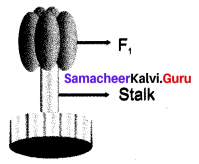
Question 4.
Name the three basic tissues system in flowering plants.
Answer:
The three basic tissue system in flowering plants are:
- Dermal or Epidermal tissue system
- Ground tissue system
- Vascular tissue system
Question 5.
What is photosynthesis and wherein a cell does it occur?
Answer:
Photosynthesis is a process in which the green plants use sunlight and the green pigment chlorophyll, to synthesize, nutrients from carbon dioxide from air and water. The photosynthesis occurs in green parts of the plant such as leaves, stems and floral buds.
Question 6.
What is respiratory quotient?
Answer:
The ratio of volume of carbon dioxide liberated and the volume of oxygen consumed, during respiration is called Respiratory Quotient (R.Q)
\(\mathrm{R} . \mathrm{Q} .=\frac{\text { Volume of } \mathrm{CO}_{2} \text { liberated }}{\text { Volume of } \mathrm{O}_{2} \mathrm{consumed}}\)
Question 7.
Why should the light dependent reaction occur before the light independent reaction?
Answer:
During light dependent reaction photosynthesis pigment absorb the light energy and convert it into chemical energy ATP and NADPH2.
During light independent CO2 is reduced into carbohydrates with the help of ATP and NADPH2 produced during light dependent reaction.
Question 8.
Write the reaction for photosynthesis.
Answer:

VII. Long Answer Questions
Question 1.
Differentiate the following
(a) Monocot root and Dicot root
(b) Aerobic and Anaerobic respiration.
Answer:
(a) Monocot root and Dicot root
| Dicot Root | Monocot Root |
| 1. The Xylem is Tetrarch | 1. The Xylem is Polyarch. |
| 2. The conjunctive tissue is made up of parenchyma cells. | 2. The conjunctive tissue is made up of sclerenchyma cells. |
| 3. The young root contains a path, but in the old root, pith is absent. | 3. Pith cells are made of parenchyma cells with intercellular spaces and contain abundant starch grains. |
| 4. Cambium is present during secondary growth. | 4. Cambium is absent. |
| 5. Secondary growth is present. | 5. Secondary growth is absent. |
(b) Aerobic and Anaerobic respiration
| Aerobic | Anaerobic |
| 1. Occur in the presence of oxygen. | 1. Occurs, when oxygen is absent. |
| 2. Carbon dioxide, water and ATP are produced. | 2. Lactic acid, Ethanol and ATP are produced. |
3. It consists of 3 steps:
|
3. It consists of 2 steps:
|
Question 2.
Describe and name three stages of cellular respiration that aerobic organisms use to obtain energy from glucose.
Answer:
The three stages of Aerobic respiration are:
(i) Glycolysis (Glucose splitting): It is the breakdown of one molecule of glucose into two molecules of pyruvic acid. Glycolysis takes place in the cytoplasm of the cell. It is the first step of both aerobic and anaerobic respiration.
(ii) Krebs Cycle: This cycle occurs in the mitochondria matrix. At the end of glycolysis, 2 molecules of pyruvic acid enter into mitochondria. The oxidation of pyruvic acid into CO2 and water takes place through this cycle. It is also called the Tricarboxylic Acid Cycle (TCA).
(iii) Electron Transport Chain: This is accomplished through a system of electron carrier complex called electron transport chain (ETC) located on the inner membrane of the mitochondria. NADH2 and FADH2 molecules formed during glycolysis and Krebs cycle are oxidised to NAD+ and FAD+ to release the energy via electrons. As they move, the electron release energy which is trapped by ADP to synthesis ATP. This is called oxidative phosphorylation. In this O2 gets reduced to water.
Question 3.
How does the light – dependent reaction differ from the light – independent reaction? What are the end products and reactants in each? Where does each reaction occur within the chloroplast?
Answer:
Light – dependent photosynthesis is called Hill reaction or Light reaction. The Light independent reactions are called Biosynthetic phase.
| Light-dependent reaction | Light independent reaction |
| 1. It is called Hill reaction or Light reaction. | 1. It is called Dark reaction or Biosynthetic pathway or the Calvin cycle. |
| 2. The reaction is carried out in Thylakoid membranes (Grana) of the chloroplast. | 2. This reaction is carried out in the stroma of the chloroplast. |
| 3. Photosynthetic pigments absorb the light energy and convert it into chemical energy ATP and NADPH2. | 3. CO2 is reduced into carbohydrates with the help of light generated ATP and NADPH2. |
| 4. It is carried out in the presence of light. | 4. It is carried out in the absence of light. |
In the light – dependent reaction, the chlorophyll absorbs the light energy and convert it into chemical energy ATP and NADPH2. In the light – independent reaction, CO2 is reduced into carbohydrates with the help of light generated ATP and NADPH2. The light – dependent reaction is carried out in the Grana of the chloroplast. The Light independent reaction is carried out in the stroma of the chloroplast.
VIII. Higher Order Thinking Skills(HOTS) Questions
Question 1.
The reactions of photosynthesis make up a biochemical pathway.
(A) What are the reactants and products for both light and dark reactions?
(B) Explain how the biochemical pathway of photosynthesis recycles many of its own reactions and identify the recycled reactants.
Answer:
(a) Light reactions are carried out in the Thylakoid membranes (Grana) of the chloroplast which use water and energy from the Sun to produce NADPH, ATP and Oxygen. The Dark reaction is carried out in the stroma of the chloroplast. It uses NADPH, ATP and CO2 and produces NADP + ADP + P and high energy sugars.
(b) The Light reactions use light to synthesize ATP and NADPH. The dark reaction or Calvin cycle uses these reactants to produce sugar from additional CO2 molecule. This cycle then produces NAP + ADP + P; (inorganic phosphate) which is used in the light reactions, with water molecules to produce ATP and NADPH again.
![]()
Question 2.
Where do the light-dependent reaction and the Calvin cycle occur in the chloroplast?
Answer:
Light-dependent reaction takes place in the presence of light energy in thylakoid membranes (grana) of the chloroplast Calvin cycle occurs at the stroma of the chloroplast.
Samacheer Kalvi 10th Science Plant Anatomy and Plant Physiology Additional Questions Solved
I. Choose the correct answer
Question 1.
The father of Plant Anatomy is _____.
(a) Melvin Calvin
(b) C.N.R. Rao
(c) Robin Hill
(d) Nehemiah Grew.
Answer:
(d) Nehemiah Grew.
Question 2.
The passage cells are found in endodermis of:
(a) dicot stem
(b) monocot stem
(c) dicot root
(d) dicot leaf
Answer:
(c) dicot root
Question 3.
The vascular bundle consists of _____.
(a) Xylem and Phloem
(b) Hypodermis and Endodermis
(c) Cortex and Pericycle
(d) Pith and Stele.
Answer:
(a) Xylem and Phloem
Question 4.
The vascular bundles are skull shaped in:
(a) dicot root
(b) monocot root
(c) dicot stem
(d) monocot stem
Answer:
(d) monocot stem
Question 5.
The protoxylem lacuna is present in the vascular bundles of:
(a) dicot root
(b) monocot root
(c) dicot stem
(d) monocot stem
Answer:
(d) monocot stem
II. Fill in the blanks
Question 1.
The epidermis has many minute pores called _____.
Answer:
Stomata.
Question 2.
Epiblema, the outermost layer of the root is called ____ or _____ layer.
Answer:
Rhizodermis or Piliferous.
![]()
Question 3.
All the tissues, inner to Endodermis constitute _____.
Answer:
Stele.
Question 4.
______ provides mechanical support to plants.
Answer:
Sclerenchyma.
Question 5.
The barrel-shaped innermost layer of Dicot stem Endodermis is also called _____.
Answer:
Starch Sheath.
Question 6.
Each vascular bundle of monocot stem is surrounded by a few-layer of sclerenchyma cells called _____.
Answer:
Bundle Sheath
Question 7.
______ consists of sieve tubes and elements of companion cells.
Answer:
Phloem.
III. State whether the statements are true or false. Correct the false statement.
Question 1.
Pith is differentiated in monocot stems.
Answer:
False.
Correct Statement: Pith is not differentiated in monocot stems.
Question 2.
In monocot leaves, the mesophyll is not differentiated into palisade and spongy parenchyma.
Answer:
True.
![]()
Question 3.
Dicot leaf is an isobilateral leaf.
Answer:
False.
Correct Statement: Monocot leaf is an isobilateral leaf.
Question 4.
The lateral roots of dicot plant originate from the stele.
Answer:
False.
Correct Statement: The lateral roots of dicot plant originate from the pericycle.
Question 5.
Cuticle and Stomata are absent in Epiblema of Dicot root.
Answer:
True.
IV. Match the following
Question 1.
| 1. Leukoplast | (a) Photosystems |
| 2. Accessory pigments | (b) Inner mitochondrial membrane |
| 3. Chlorophyll | (c) Chlorophyll and Carotenoids |
| 4. Cristae | (d) Colourless plastids |
| 5. Chl.a and Accessory pigments | (e) Green pigment |
Answer:
1. (d) Colourless plastids
2. (c) Chlorophyll and Carotenoids
3. (e) Green pigment
4. (b) Inner mitochondrial membrane
5. (a) Photosystems.
V. Short Answer Questions
Question 1.
Where does the break down of pyruvate to give carbondioxide, water and energy takes place?
Answer:
The break down of pyruvate to give carbondioxide. water and energy takes place in Mitochondria.
Question 2.
Draw the overview of Hill and Calvin Cycle.
Answer:
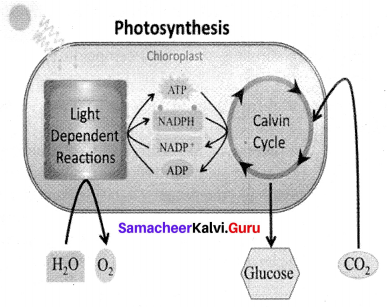
Question 3.
Name the energy currency in the living organism. When and where it is produced?
Answer:
Adenosine Triphosphate (ATP) is called the energy currency in the living organism. It is produced in mitochondria during the process of respiration.
Question 4.
What are Bulliform cells?
Answer:
Some of the upper epidermal cells of monocot leaves are large and thin-walled. So they are called Bulliform cells.
Question 5.
Label the parts of the transverse section of Dicot Root.
Answer:
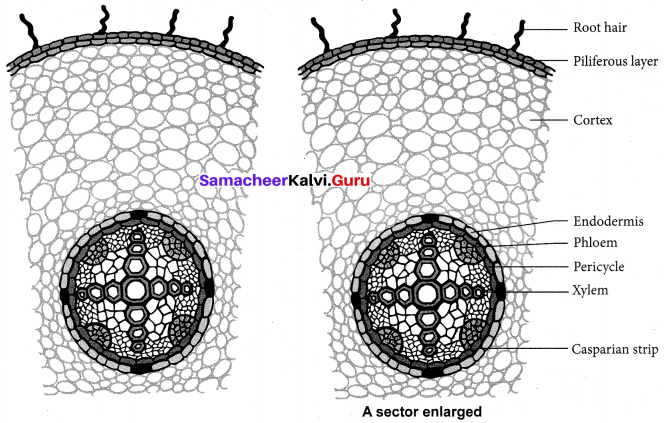
Question 6.
Define conjuctive tissue.
Answer:
The tissue present between xylem and phloem is called conjuctive tissue. In monocot the conjuctive tissue is sclerenchymatous tissue and in dicot it is parenchymatous tissue.
Question 7.
List out the two important factors which affect photosynthesis.
Answer:
- Internal Factors:
- Pigments
- Leafage
- Accumulation of carbohydrates
- Hormones
- External Factors:
- Light
- Carbon dioxide
- Temperature
- Water
- Mineral elements
Question 8.
Mention the components and functions of different Tissue Systems.
Answer:
| Tissue System | Components | Functions |
| Dermal Tissue System | Epidermis and Periderm (in older stems and roots) |
|
| Ground Tissue System |
|
|
| Vascular Tissue System |
|
|
VI. Long Answer Questions
Question 1.
(a) Label the parts of the Transverse section of a monocot stem.
(b) Mention the differences between Dicot and Monocot stem.
Answer:
(a)
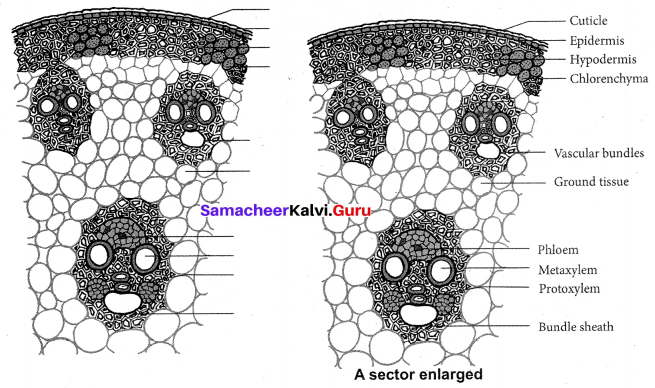
(b)
| Tissues | Dicot Stem | Monocot stem |
| 1. Hypodermis | collenchymatous | Sclerenchymatous |
| 2. Ground tissue | Differentiated into cortex, endodermis, pericycle and pith | Undifferentiated |
| 3. Vascular bundles |
|
|
| 4. Secondary growth | Present | Mostly absent |
| 5. Pith | Present | Absent |
| 6. Medullary rays | Present | Absent |
Question 2.
With a labelled diagram, explain the structure and function of mitochondria.
Answer:
Mitochondrial Membranes: It consists of two membranes called inner and outer membrane. Each membrane is 60 – 70 A° thick. The outer mitochondrial membrane is smooth and freely permeable to most small molecules. It contains enzymes, proteins and lipids. It has porin molecules (proteins) which form channels for passage of molecules through it.
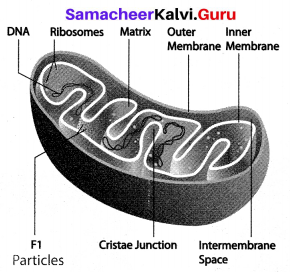
The inner mitochondrial membrane is semi – permeable membrane and regulates the passage of materials into and out of the mitochondria. It is rich in enzymes and carrier proteins. It consists of 80% of proteins and lipids.
Cristae: The inner mitochondrial membrane gives rise to finger-like projections called cristae. These cristae increase the inner surface area (fold in the inner membrane) of the mitochondria to hold a variety of enzymes.
Oxysomes: The inner mitochondrial membrane bear minute regularly spaced tennis racket shaped particles known as oxysomes (F1 particle). They involve in ATP synthesis.
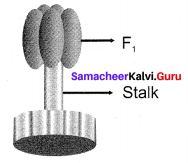
Mitochondrial matrix: It is a complex mixture of proteins and lipids. The matrix contains enzymes for Krebs cycle, mitochondrial ribosomes(70 S), tRNAs and mitochondrial DNA.
Question 3.
(a) Draw and label the ultrastructure of a chloroplast.
(b) Write the structure and function of the chloroplast.
Answer:
(a) Ultra Structure of a Chloroplast.
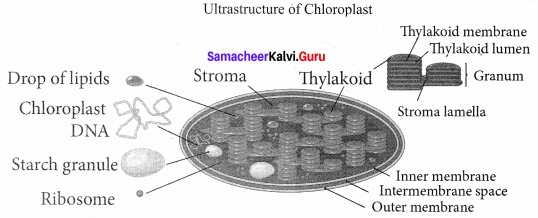
(b) Structure and function of Chloroplast.
Chloroplasts are green plastids, containing the green pigment called Chlorophyll. It has the following structures:
- Envelope: It has outer and inner membranes, which are separated by intermembrane space.
- Stroma: Matrix present inside to the membrane is called stroma, which contains DNA, 70 S ribosomes and other molecules needed for protein synthesis.
- Thylakoids: It consists of thylakoid membrane that encloses thylakoid lumen. Thylakoid forms a stack of disc – like structures called granum.
- Grana: Some of the thylakoids are arranged in the form of discs, stacked one above the other called grana. These stacks are termed as grana, they are interconnected to each other by membranous lamellae called Fret channels.
Functions:
- Photosynthesis
- Storage of starch
- Synthesis of fatty acids
- Storage of lipids
- Formation of chloroplasts.
VIII. Higher Order Thinking Skills (HOTS) Questions
Question 1.
What are non – green plants? Give an example.
Answer:
The plants, which do not have the green pigment, Chlorophyll and so they cannot prepare their food independently are called non-green plants. Eg. Orchids lack Chlorophyll.
Question 2.
Protophloem is the first formed phloem. If the protophloem surrounds by xylem, what kind of arrangement of phloem would you call it Give example.
Answer:
If the protophloem is surrounded by xylem the vascular bundle is said to be Concentric Amphivasal Vascular bundles. Eg: Dracaena
Question 3.
How does photosynthesis take place on plants that have, red, brown and yellow leaves, and are not green? How do they prepare food?
Answer:
These leaves have a much larger concentration of chromoplasts, which synthesize and store pigments such as orange carotenes, yellow xanthophylls and other red pigments. But these leaves, still possess chlorophyll ‘a’ and chlorophyll ‘b’ and can synthesize food. But these leaves have more chromoplasts and so the leaves do not appear green. Yet they can prepare food.
Question 4.
The cross-section of a plant material shown the following features on viewing under the microscope.
(a) Radially arranged Vascular bundles
(b) Xylem is exarch and polyarch
(c) Metaxylem is polygonal in shape.
Identify the slide.
Answer:
The given features are characters of dicot root